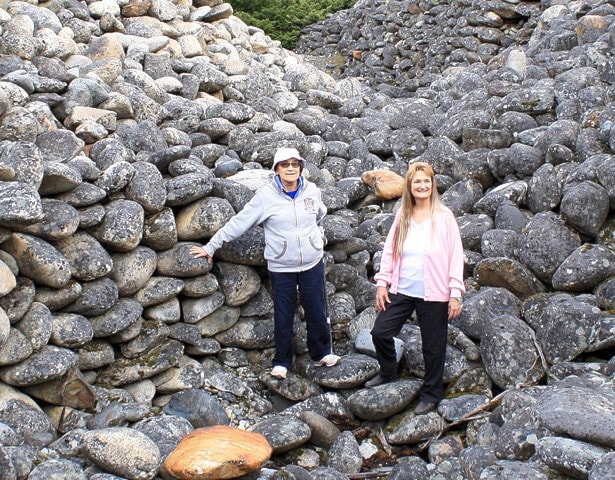Bernie Fandrich
Strong evidence of Chinese involvement in the Fraser River Gold Rush that began in 1858 lies in stacked rows of rocks along the river corridor. Two such sites on the west side of the river—one just upstream from Lytton, the other halfway to Lillooet—recently received Chinese Historical Places Site designation from the B.C. government.
The Rip Van Winkle Flat and Browning’s Flat sites exemplify the years of back-breaking labour that Chinese, First Nations, and others undertook in pursuit of the precious metal.
The application for the special designation was primarily the work of John Haugen at the Nlaka’pamux Nation Tribal Council (NNTC). Tawnya Collins in the NNTC office helped John piece together the detailed application, and Sara Ling, Henry Chu, and Michael Kennedy provided guidance and expert advice.
Browning’s Flat has archaeological features that have remained relatively untouched in the almost 150 years since Chinese miners created monumental drainage ditches and stacks of rocks that stretch for kilometres. It is accessible primarily from the river or by air.
Rip Van Winkle Flat is accessible via reaction ferry across the Fraser at Lytton. Becky Mundall’s family owns land that borders the Van Winkle site.
“Every time I look at the millions of rocks that are neatly stacked in rows or in piles, I marvel at how hard the Chinese worked,” she says. “It must have taken them years to move them all, one rock at a time.”
Both sites include rock water channels and piles of washed and stacked rock, surface artifacts, and other signs of mining typical of the many placer mining bars along the Fraser River.
“I grew up on the west side of the Fraser,” says Margo Soper. “Almost every day when I was young I saw those stacks of rocks and you know, I never thought about how they got there, or how hard the Chinese and some of my Native ancestors had to work to find gold.
“I remember hearing about a Chinese man who had a general store with some mining stuff close to Van Winkle Flats. One day some guy on horseback rode in and shot the merchant because he wouldn’t sell him any vanilla.” After a pause, Margo continues: “I don’t think they ever caught him.”
Strong evidence suggests that the number of Chinese and Native miners was almost equal after the initial surge of the 1858 gold rush.
An awe-inspiring site, the stacks of rocks that remain along 600 kilometers of the Fraser make them one of the largest visible artifacts of early B.C. history. It’s fitting that the B.C. Heritage Branch has given two of them near Lytton special recognition.
